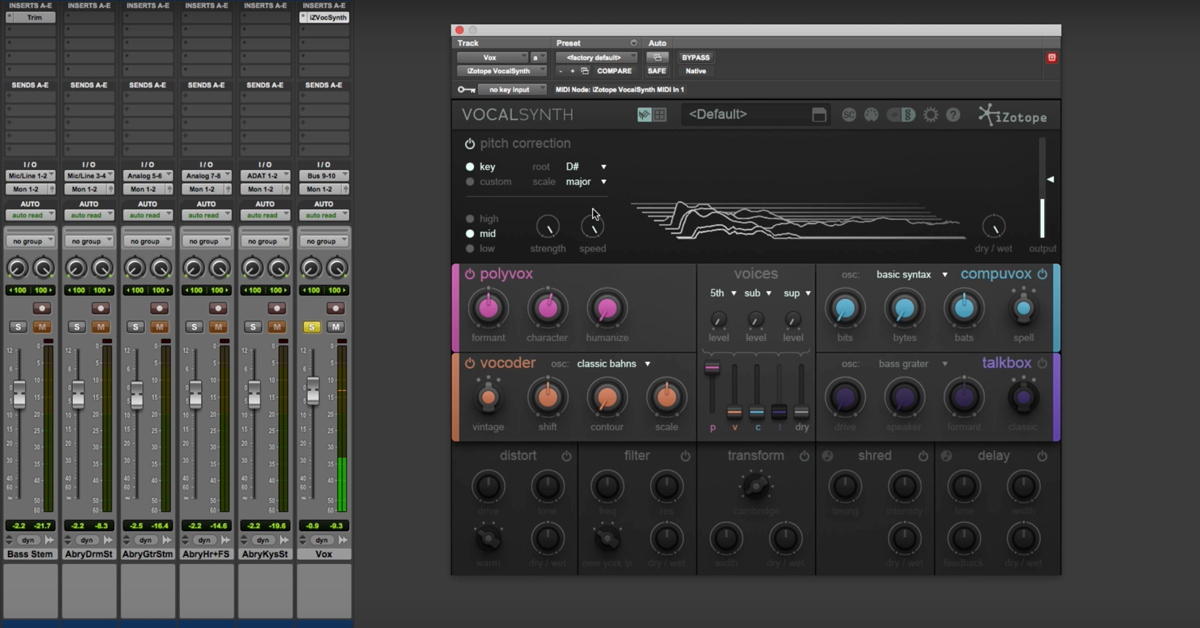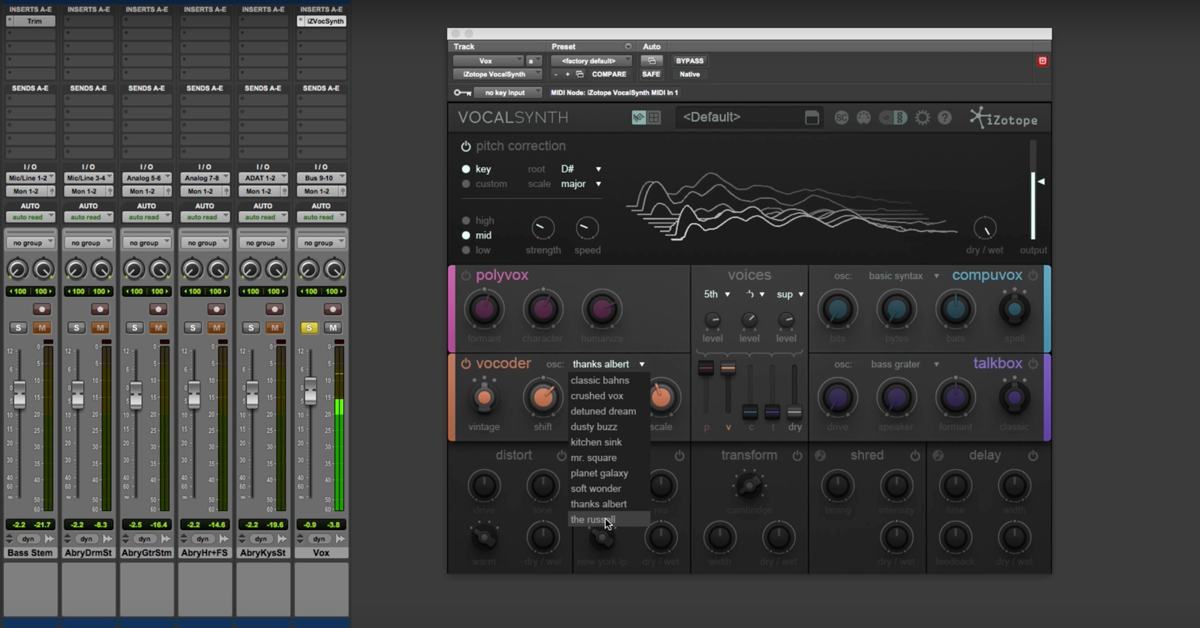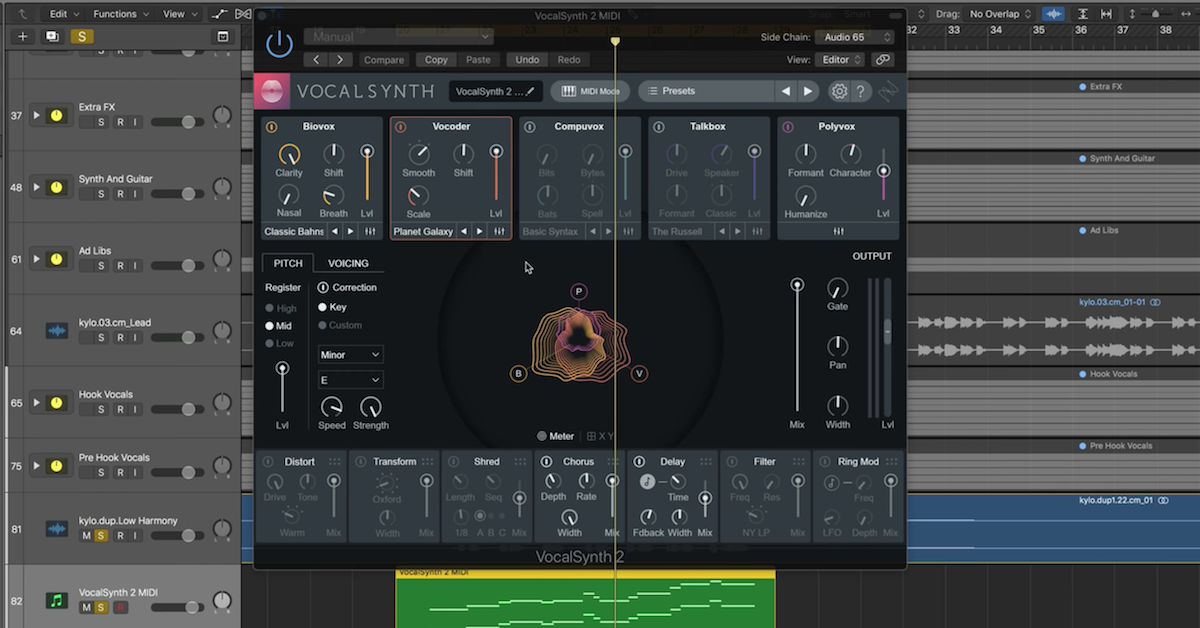iZotope VocalSynth: Basic Processing Effects (Part 3)
This is a final video in a three part series where I’m taking a look at a brand new plug-in that was just released from iZotope. It’s called the VocalSynth.
In my first video, I showed off a bunch of the different presets that come with this plug-in to give you an idea about the wide range of sounds that you can achieve with this plug-in. I also demonstrated the pitch correction section of this plug-in. I called this the pre-processing section, because pitch correction is going to happen one of the first things when the signal comes into the processor.
With the pitch correction module, you can achieve everything from very subtle, mild forms of pitch correction, all the way up to very extreme, T-Pain like effects. So after pitch correction, that’s when we’re going to move into the main processing section of this plug-in.
You have several different modules that accomplish different kinds of vocal synthesis, or different kinds of vocal effects. Everything from different forms of harmonies, you can have vocoder kinds of effects… A very unique sort of Compuvox. This module here — very wide range of sounds. Then also the talkbox kinds of effects.
So each of these are running in parallel with each other. After this main section, where most of the action happens in the plug-in, then the signal ends up at what I’ll call the post-processing section, where you have more typical kinds of effects that are really just there to polish up, or shape, add some little extra spice on top of what you’ve already accomplished.
You’ve got things in here like your typical delays, to distortion, filtering, low pass filters, high-pass filters, and so on. I’m going to focus on this section of the plug-in and show you the different modules down here, and then I’ll also wrap it up with kind of my summary, or my thoughts on the plug-in in general.
So let’s get to it. Play back some of my vocal sound. What I’ve got right now, just dialed in with some of the synthesis happening, and then I’ll bring in some of these additional processing modules.
[vocals with VocalSynth]
Alright, so this is the sound I’ll work with. You have some of the dry sound, and then also some of the synthesized sound.
Let’s bring in some of these additional processing modules. We’ll start off with delay, because that’s a simple, easy one to hear, right? Basic controls. Not trying to do anything too fancy with the delay, just create some additional repetitions.
[vocals, with delay in VocalSynth]
So everything from very wide stereo delays, to just your typical mono slapback sound.
[vocals with delay in VocalSynth]
Another thing you can do, they’ve got this musical note — eighth note up here that lets you tempo synchronize the time of these different effects.
[vocals with delay, tempo synced]
So that’s a convenient thing whenever you have the tempo setup for your song.
Let’s take a look at the distortion module. This is another common one that you’ll want to find, and then I’ll get into some of the other more unique ones.
So here’s distortion. You actually have several different sounds. The warm is the least amount of distortion, all the way up to fuzz, which is very extreme amounts of distortion. Drive is how much you want to — for each different sound — how much you’re going to add in.
[vocals with distortion]
Alright, next up, the filter section. This is where you can do things like low pass filters, high pass filters… These are your common kinds of things you’ll find in EDM style music, especially if you’re trying to do some sweeps and that kind of thing.
[vocals with filters]
So that’s a low pass filter. I’ve also got high pass filters.
[vocals with high pass filters]
So some very nice spectral shaping possibilities there.
Now let me get into some of these other ones. The transform one.
This comes up with some kind of, you know, unique sorts of sounds. A little bit on the saturation side of things too.
[vocals with transform module]
So some kind of combination on here in between some spectral processing, like when you turn on the radio setting, and additional sorts of things too.
[vocals with VocalSynth]
Next, let’s move onto Shred. This is another one. Has it’s own sort of things you can do with it, including tempo synchronize the timing of things.
[vocals with Shred module]
So it’s capable of these glitch kind of affects that people associate that you might want to — normally, you’d have to spend all of this time and effort to chop up your vocal file and do all of this stuff to accomplish it. It’s built in a kind of unique sort of randomized things into this processor.
[vocals with Shred module]
So lots of different sounds that you can come up with.
That’s individually. Again, then it’s just a matter of combining these things together. Maybe adding some distortion, some delay and filtering… Let’s listen to how that sounds.
[vocals with VocalSynth modules]
And remember, all of these parameters are going to be automatable. You can go in after the fact and automate things like the filter frequency, speakers, all of these controls, you can change on the fly to go along with your song.
So I guess that kind of just gives you an idea about the different sections of the plug-in and how to tweak them to just come up with your basic sorts of sounds. Provide a few of my own comments, then, about this brand new processor.
I think that it’s going to be very useful for a number of different people. Producers, engineers that have to work with certain styles of music, and also, things like sound for film, sound for picture, and that sort of thing. It’s definitely has a very unique niche and target audience for what it’s trying to accomplish, because it’s coming up with these very unique sorts of sounds and creative kinds of vocal effects.
This isn’t going to be your Swiss Army Knife channel strip that you just do compression, equalization, and all of that kind of stuff in here.
This plug-in is going to be if you have all of that stuff already done, and you just need to add a bit of that extra flavor on top of what you’ve already got. So if that’s what you need, that your certain styles of music that you’re working in, this plug-in’s for you.
I think it’s nice. It’s laid out well, it has a cool looking interface, very simple, easy to use, almost anyone is going to be able to pull it up, maybe adjust some parameters on a preset, and find some sound that’s pretty close to what they’re looking for.
You can’t go too deep into it because really, just the parameters are set in stone, what you’re seeing on the screen, but if you need anything — you know, you could break this down into the different sections.
If you just need a plug-in that can do pitch correction, this has got that. If you need a simple plug-in that can do things like delay, distortion, and filtering, you could bypass all of the synthesis portions of this plug-in and just use those things. They sound great.
But if you’re looking for those really unique sort of strange sounds for vocals, this is, as far as I’m concerned, the easiest plug-in for you to use where you’re just dialing in a few knobs, coming up, turning on some different things to tweak, run these things in parallel, and you’ve got an extremely wide range of sounds that you can accomplish with just one simple plug-in.
So I definitely give it my recommendation. Check it out, download it free. A demo version of it, and try it out for yourself.
So that’s all I’ve got. Until next time, take care, guys.





